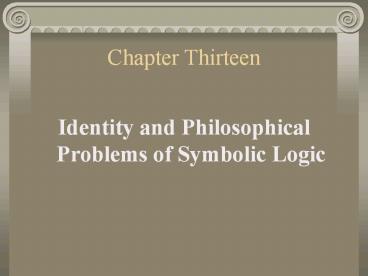Chapter Thirteen - PowerPoint PPT Presentation
1 / 33
Title:
Chapter Thirteen
Description:
Title: PowerPoint Presentation Author: james Last modified by: james stacey taylor Created Date: 4/18/2003 8:25:52 PM Document presentation format – PowerPoint PPT presentation
Number of Views:66
Avg rating:3.0/5.0
Title: Chapter Thirteen
1
Chapter Thirteen
- Identity and Philosophical Problems of Symbolic
Logic
2
1. Identity
- We use the identity symbol so we can
correctly translate statements of identity into
our logical notation. - The rule of identity (ID) states that we can
translate identicals into identicals. - The rule of Identity Reflexivity (IR) allows
introduction of the formula (x)(x x) into a
proof at any time.
3
2. Definite Descriptions
- A description that picks out one definite entity
is a definite description.
4
3. Properties of Relations
- Relational properties are used in mathematics and
the sciences to generate orders between things.
5
Properties of Relations, continued
- A relation is symmetrical iff when one thing
bears that relation to the second the second must
bear it to the first. - A relation is asymmetrical iff when one thing
bears that relation to a second, the second thing
cannot bear it to the first.
6
Properties of Relations, continued
- All two-place relations are transitive,
intransitive, or nontransitive.
7
Properties of Relations, continued
- A relation is transitive iff when one thing bears
that relation to a second, and the second to a
third, then the first must bear it to the third.
8
Properties of Relations, continued
- A relation is intransitive iff when one thing
bears that relation to a second, and the second
to a third, then the first cannot bear it to the
third.
9
Properties of Relations, continued
- All relations that are neither transitive or
intransitive are nontransitive.
10
Properties of Relations, continued
- A situation is totally reflexive iff everything
must bear that relation to itself.
11
Properties of Relations, continued
- A relation is reflexive iff x bears that relation
to y, then x must bear it to itself.
12
Properties of Relations, continued
- A relation is irreflexive iff nothing can bear
that relation to itself.
13
4. Higher-Order Logics
- A predicate logic that forbids sentences that
ascribe properties to properties themselves and
restricts quantification to individual variables
is a first-order predicate logic.
14
Higher-Order Logics, continued
- In a higher-order logic, we can have property
variables as well as individual variables. - In a higher-order logic properties can have
properties.
15
5. Limitations of Predicate Logic
- There seem to be arguments that, while invalid
using the notation and proof techniques of
predicate logic, are valid in some wider (perhaps
ideal) deductive system, for example, arguments
using indirect or intensional contexts.
16
Limitations of Predicate Logic, continued
- Contexts that use terms that refer to states of
the mind are called intentional contexts. - These are a species of intensional contexts.
17
Limitations of Predicate Logic, continued
- Arguments with missing premises are called
enthymemes.
18
Limitations of Predicate Logic, continued
- Dispositional properties are powers, potentials,
or dispositions of objects.
19
Limitations of Predicate Logic, continued
- It has been suggested that the correct analysis
of dispositional sentences is into subjunctive or
contrary-to-fact conditionals.
20
6. Philosophical Problems
- One basic philosophical issue concerns whether
logic deals with sentences or propositions.
21
Philosophical Problems, continued
- Sentential logic is a two-valued truth-functional
logic. But it has been argued that most natural
language sentences do not have two truth-values.
22
Philosophical Problems, continued
- There are philosophical issues concerning the
status of sentence connectives in predicate logic.
23
Philosophical Problems, continued
- There are philosophical difficulties with
truth-functional connectives. - For example, the use of a truth-functional
conditional has been objected to on the grounds
that is generates so-called paradoxes of material
implication.
24
Philosophical Problems, continued
- It is not clear what a deductively valid
argument is, since the terms must and
impossible that are used to describe such
arguments are ambiguous.
25
7. Logical Paradoxes
- Higher-order logics are plagued by logical
paradoxes.
26
Logical Paradoxes, continued
- If we allow the predication of properties to
properties, then syntactic paradoxes can be
generated, such as the impredicable paradox.
27
Logical Paradoxes, continued
- A property that can be truly predicated of itself
is a predicable property, and a property that
cannot be predicated of itself is an impredicable
property.
28
Logical Paradoxes, continued
- Is the property of being impredicable predicable
or impredicable? - One solution to this paradox is the simple theory
of types.
29
Logical Paradoxes, continued
- There are also semantic paradoxes, such as the
paradox of the liar. - One way to solve these paradoxes is to
distinguish between levels of language languages
used to talk about non-linguistic things and
languages used to talk about language.
30
Key Terms
- Asymmetrical relation
- Contrary-to-fact conditional (counterfactual)
- Definite description
- Dispositional property
- Enthymeme
- First-order predicate logic
- Impredicable paradox
- Indirect context
31
Key Terms, continued
- Intensional context
- Intentional context
- Intransitive relation
- Inflexive relation
- Levels of language theory
- Logical paradoxes
- Nonreflexive relation
- Nonsymmetrical relation
32
Key Terms, continued
- Nontransitive relation
- Paradoxes of material implication
- Property variable
- Reflexive relation
- Semantic paradox
- Sentence token
- Sentence type
- Simple theory of types
33
Key Terms, continued
- Subjunctive conditional
- Symmetrical relation
- Syntactic paradox
- Totally reflexive relation
- Transitive relation































